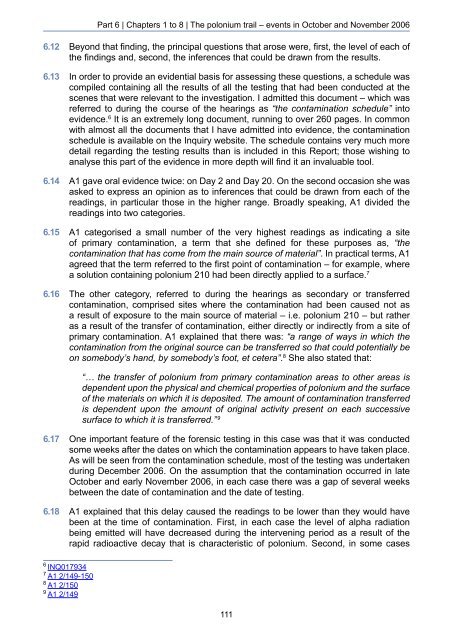The Litvinenko Inquiry
JIEp7Zyr
JIEp7Zyr
You also want an ePaper? Increase the reach of your titles
YUMPU automatically turns print PDFs into web optimized ePapers that Google loves.
Part 6 | Chapters 1 to 8 | <strong>The</strong> polonium trail – events in October and November 2006<br />
6.12 Beyond that finding, the principal questions that arose were, first, the level of each of <br />
the findings and, second, the inferences that could be drawn from the results.<br />
6.13 In order to provide an evidential basis for assessing these questions, a schedule was<br />
compiled containing all the results of all the testing that had been conducted at the<br />
scenes that were relevant to the investigation. I admitted this document – which was<br />
referred to during the course of the hearings as “the contamination schedule” into<br />
evidence. 6 It is an extremely long document, running to over 260 pages. In common<br />
with almost all the documents that I have admitted into evidence, the contamination<br />
schedule is available on the <strong>Inquiry</strong> website. <strong>The</strong> schedule contains very much more<br />
detail regarding the testing results than is included in this Report; those wishing to<br />
analyse this part of the evidence in more depth will find it an invaluable tool.<br />
6.14 A1 gave oral evidence twice: on Day 2 and Day 20. On the second occasion she was<br />
asked to express an opinion as to inferences that could be drawn from each of the<br />
readings, in particular those in the higher range. Broadly speaking, A1 divided the<br />
readings into two categories.<br />
6.15 A1 categorised a small number of the very highest readings as indicating a site<br />
of primary contamination, a term that she defined for these purposes as, “the<br />
contamination that has come from the main source of material”. In practical terms, A1<br />
agreed that the term referred to the first point of contamination – for example, where<br />
a solution containing polonium 210 had been directly applied to a surface. 7<br />
6.16 <strong>The</strong> other category, referred to during the hearings as secondary or transferred<br />
contamination, comprised sites where the contamination had been caused not as<br />
a result of exposure to the main source of material – i.e. polonium 210 – but rather<br />
as a result of the transfer of contamination, either directly or indirectly from a site of<br />
primary contamination. A1 explained that there was: “a range of ways in which the<br />
contamination from the original source can be transferred so that could potentially be<br />
on somebody’s hand, by somebody’s foot, et cetera”. 8 She also stated that:<br />
“… the transfer of polonium from primary contamination areas to other areas is<br />
dependent upon the physical and chemical properties of polonium and the surface<br />
of the materials on which it is deposited. <strong>The</strong> amount of contamination transferred<br />
is dependent upon the amount of original activity present on each successive<br />
surface to which it is transferred.” 9<br />
6.17 One important feature of the forensic testing in this case was that it was conducted<br />
some weeks after the dates on which the contamination appears to have taken place.<br />
As will be seen from the contamination schedule, most of the testing was undertaken<br />
during December 2006. On the assumption that the contamination occurred in late<br />
October and early November 2006, in each case there was a gap of several weeks<br />
between the date of contamination and the date of testing.<br />
6.18 A1 explained that this delay caused the readings to be lower than they would have<br />
been at the time of contamination. First, in each case the level of alpha radiation<br />
being emitted will have decreased during the intervening period as a result of the<br />
rapid radioactive decay that is characteristic of polonium. Second, in some cases<br />
6<br />
INQ017934<br />
7<br />
A1 2/149-150<br />
8<br />
A1 2/150<br />
9<br />
A1 2/149<br />
111


